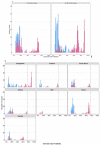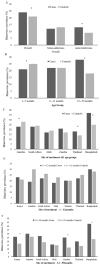Epidemiology of the Rhinovirus (RV) in African and Southeast Asian Children: A Case-Control Pneumonia Etiology Study
- PMID: 34198998
- PMCID: PMC8310211
- DOI: 10.3390/v13071249
Epidemiology of the Rhinovirus (RV) in African and Southeast Asian Children: A Case-Control Pneumonia Etiology Study
Abstract
Rhinovirus (RV) is commonly detected in asymptomatic children; hence, its pathogenicity during childhood pneumonia remains controversial. We evaluated RV epidemiology in HIV-uninfected children hospitalized with clinical pneumonia and among community controls. PERCH was a case-control study that enrolled children (1-59 months) hospitalized with severe and very severe pneumonia per World Health Organization clinical criteria and age-frequency-matched community controls in seven countries. Nasopharyngeal/oropharyngeal swabs were collected for all participants, combined, and tested for RV and 18 other respiratory viruses using the Fast Track multiplex real-time PCR assay. RV detection was more common among cases (24%) than controls (21%) (aOR = 1.5, 95%CI:1.3-1.6). This association was driven by the children aged 12-59 months, where 28% of cases vs. 18% of controls were RV-positive (aOR = 2.1, 95%CI:1.8-2.5). Wheezing was 1.8-fold (aOR 95%CI:1.4-2.2) more prevalent among pneumonia cases who were RV-positive vs. RV-negative. Of the RV-positive cases, 13% had a higher probability (>75%) that RV was the cause of their pneumonia based on the PERCH integrated etiology analysis; 99% of these cases occurred in children over 12 months in Bangladesh. RV was commonly identified in both cases and controls and was significantly associated with severe pneumonia status among children over 12 months of age, particularly those in Bangladesh. RV-positive pneumonia was associated with wheezing.
Keywords: PERCH; childhood; epidemiology; pneumonia; rhinovirus.
Conflict of interest statement
S.A.M. has received honoraria for advisory board participation from Bill & Melinda Gates Foundation, Pfizer, Medimmune, and Novartis and institutional grants from GSK, Novartis, Pfizer, Minervax, and Bill & Melinda Gates Foundation and has served on speakers’ bureaus for Sanofi Pasteur and GSK. M.D.K. has received funding for consultation from Merck, Pfizer, and Novartis and grant funding from Merck. C.P. has received grant funding from Merck. K.L.O. has received grant funding from GlaxoSmithKline and Pfizer and participates on technical advisory boards for Merck, Sanofi-Pasteur, PATH, Affinivax, and ClearPath. K.L.K. has received grant funding from Merck Sharp & Dohme. W.A.B. reported funding from Sanofi, PATH, and Bill & Melinda Gates Foundation (BMGF) and contributed to contemporaneous studies from Serum Institute of India, LTD, Roche, and Sanofi. All other authors: No reported conflicts. Conflicts that the editors consider relevant to the content of the manuscript have been disclosed.
Figures



Similar articles
-
A prospective case-control study on the association of Rhinovirus nasopharyngeal viral load and viremia in South African children hospitalized with severe pneumonia.J Clin Virol. 2020 Apr;125:104288. doi: 10.1016/j.jcv.2020.104288. Epub 2020 Feb 11. J Clin Virol. 2020. PMID: 32092643 Free PMC article.
-
Molecular Subtyping of Human Rhinovirus in Children from Three Sub-Saharan African Countries.J Clin Microbiol. 2019 Aug 26;57(9):e00723-19. doi: 10.1128/JCM.00723-19. Print 2019 Sep. J Clin Microbiol. 2019. PMID: 31270180 Free PMC article.
-
Rhinovirus C is associated with wheezing and rhinovirus A is associated with pneumonia in hospitalized children in Morocco.J Med Virol. 2017 Apr;89(4):582-588. doi: 10.1002/jmv.24684. Epub 2016 Sep 30. J Med Virol. 2017. PMID: 27677921 Free PMC article.
-
Rhinovirus - not just the common cold.J Infect. 2017 Jun;74 Suppl 1:S41-S46. doi: 10.1016/S0163-4453(17)30190-1. J Infect. 2017. PMID: 28646961 Review.
-
Impact of Rhinovirus Infections in Children.Viruses. 2019 Jun 5;11(6):521. doi: 10.3390/v11060521. Viruses. 2019. PMID: 31195744 Free PMC article. Review.
Cited by
-
Characterization of bacterial and viral pathogens in the respiratory tract of children with HIV-associated chronic lung disease: a case-control study.BMC Infect Dis. 2024 Jun 26;24(1):637. doi: 10.1186/s12879-024-09540-5. BMC Infect Dis. 2024. PMID: 38926682 Free PMC article.
-
Derivation and validation of a novel risk assessment tool to identify children aged 2-59 months at risk of hospitalised pneumonia-related mortality in 20 countries.BMJ Glob Health. 2022 Apr;7(4):e008143. doi: 10.1136/bmjgh-2021-008143. BMJ Glob Health. 2022. PMID: 35428680 Free PMC article.
-
Rhinovirus as the main co-circulating virus during the COVID-19 pandemic in children.J Pediatr (Rio J). 2022 Nov-Dec;98(6):579-586. doi: 10.1016/j.jped.2022.03.003. Epub 2022 Apr 19. J Pediatr (Rio J). 2022. PMID: 35490727 Free PMC article.
-
Contribution of Influenza Viruses, Other Respiratory Viruses and Viral Co-Infections to Influenza-like Illness in Older Adults.Viruses. 2022 Apr 12;14(4):797. doi: 10.3390/v14040797. Viruses. 2022. PMID: 35458527 Free PMC article.
-
Rhinovirus dynamics across different social structures.Npj Viruses. 2023;1(1):6. doi: 10.1038/s44298-023-00008-y. Epub 2023 Nov 27. Npj Viruses. 2023. PMID: 38665239 Free PMC article.
References
-
- Louie J.K., Roy-Burman A., Guardia-LaBar L., Boston E.J., Kiang D., Padilla T., Yagi S., Messenger S., Petru A.M., Glaser C.A., et al. Rhinovirus associated with severe lower respiratory tract infections in children. Pediatr. Infect. Dis. J. 2009;28:337–339. doi: 10.1097/INF.0b013e31818ffc1b. - DOI - PubMed
-
- Esposito S., Daleno C., Prunotto G., Scala A., Tagliabue C., Borzani I., Fossali E., Pelucchi C., Principi N. Impact of viral infections in children with community-acquired pneumonia: Results of a study of 17 respiratory viruses. Influenza Other Respir. Viruses. 2012;7:18–26. doi: 10.1111/j.1750-2659.2012.00340.x. - DOI - PMC - PubMed
Publication types
MeSH terms
LinkOut - more resources
Full Text Sources

